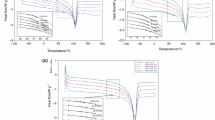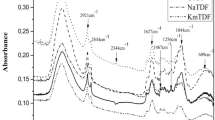Abstract
Polyethylene from renewable resources produced using sugarcane as raw material was modified with phosphonium ionic liquids. Tensile properties and thermal behavior of modified biopolyethylene in air and nitrogen atmosphere were studied. The thermal degradation of ionic liquids and their influence on thermal degradation of polyethylene from renewable resources were studied by thermogravimetric analysis (TGA). In general, modification of biopolyethylene with phosphonium ionic liquids resulted in improvement of tensile properties, i.e., tensile strength and Young’s modulus. Thermal degradation of biopolyethylene modified with phosphonium ILs proceeds in one step in the range of 400–500 °C in nitrogen atmosphere. Modification of polyethylene with trihexyltetradecylphosphonium bis(2,4,4-trimethylpentyl)phosphinate ionic liquid resulted in increase in DTGpeaks and T10% temperatures toward higher temperature for modified polyethylene in comparison with unfilled PE sample both in air and nitrogen atmosphere.





Similar content being viewed by others
References
Ghandi KA. Review of Ionic Liquids, Their Limits and Applications. Green Sustain Chem. 2014;4:44–53.
Vekariya RL. A review of ionic liquids: applications towards catalytic organic transformations. J Mol Liq. 2017;227:44–60.
Javed F, Ullah F, Zakaria MR, Akil HM. An approach to classification and hi-tech applications of room-temperature ionic liquids (RTILs): a review. J Mol Liq. 2018;271:403–20.
De Boeck M, Dehaen W, Tytgat J, Cuypers E. Microextractions in forensic toxicology: the potential role of ionic liquids. Trends Anal Chem. 2019;111:73–84.
El-Maghlany WM, Minea AA. Novel empirical correlation for ionanofluid PEC inside tube subjected to heat flux with application to solar energy. J Therm Anal Calorim. 2019;135:1161–70.
Wang W, Wu Z, Li B, Sundén B. A review on molten-salt-based and ionic-liquid-based nanofluids for medium-to-high temperature heat transfer. J Therm Anal Calorim. 2019;136:1037–51.
Patra N, Martinová L, Stuchlik M, Černík M. Structure-property relationships in Sterculia urens/polyvinyl alcoholelectrospun composite nanofibers. Carbohyd Polym. 2015;120:69–73.
Patra N, Vojtová L, Martinová L. Deacetylation-induced changes in thermal properties of Sterculia urens gum. J Therm Anal Calorim. 2015;122:235–40.
Andrade CKZ, Matos RAF, Oliveira VB, Durães JA. Sales MJA (2010) Thermal study and evaluation of new menthol-based ionic liquids as polymeric additives. J Therm Anal Calorim. 2010;99:539–43.
Mezzetta A, Perillo V, Guazzelli L, Chiappe C. Thermal behavior analysis as a valuable tool for comparing ionic liquids of different classes. J Therm Anal Calorim. 2019;138:3335–45.
Monteiro M, Maria L, Cruz A, Carretas JM, Marçalo J, Leal JP. Thermal stability and specific heats of coordinating ionic liquids. Thermochim Acta. 2020;684:178482.
Quraishi KS, Bustam MA, Krishnan S, Khan MI, Wilfred CD, Lévêque J-M. Thermokinetics of alkyl methylpyrrolidinium [NTf2] ionic liquids. Effect of alkyl chain on thermal stability. J Therm Anal Calorim. 2017;129:261–70.
Cao Y, Mu T. Comprehensive investigation on the thermal stability of 66 ionic liquids by thermogravimetric analysis. Ind Eng Chem Res. 2014;53:8651–64.
Xu Y, Xu H, Zheng Q, Song Y. Influence of ionic liquid on glass transition, dynamic rheology, and thermal stability of poly(methyl methacrylate)/silica nanocomposites. J Appl Polym Sci. 2019. https://doi.org/10.1002/APP.48007.
Yan Z, Meng D, Huang Y, Hou Z, Wu X, Wang Y, Du X, Xie H. Modification of kaolinite with alkylimidazolium salts. Nanocomposites with tunable d-spacing and thermal stability. J Therm Anal Calorim. 2014;118:133–40.
Maciejewska M, Sowińska A. Thermal characterization of the effect of fillers and ionic liquids on the vulcanization and properties of acrylonitrile–butadiene elastomer. J Therm Anal Calorim. 2019;138:4359–73.
Sowińska A, Maciejewska M. Thermal analysis applied to studying the influence of ionic liquidson the vulcanization, thermal stability and damping properties of ethylene-propylene-diene rubber. J Therm Anal Calorim. 2019;138:2669–81.
Jiang HC, Lin WC, Hua M, Pan XH, Shu CM, Jiang JC. Analysis of kinetics of thermal decomposition of melamine blended with phosphorous ionic liquid by green approach. J Therm Anal Calorim. 2018;13:2821–31.
Chen X, Feng X, Jiao C. Combustion and thermal degradation properties of flame-retardant TPU based on EMIMPF6. J Therm Anal Calorim. 2017;129:851–7.
Jiao C, Wang H, Chen X. Preparation of modified fly ash hollow glass microspheres using ionic liquids and its flame retardancy in thermoplastic polyurethane. J Therm Anal Calorim. 2018;133:1471–80.
Jiao C, Wang H, Chen X, Tang G. Flame retardant and thermal degradation properties of flame retardant thermoplastic polyurethane based on HGM@[EOOEMIm][BF4]. J Therm Anal Calorim. 2019;135:3141–52.
Jiao C, Jiang H, Chen X. Properties of fire agent integrated with molecular sieve and tetrafluoroborate ionic liquid in thermoplastic polyurethane elastomer. Polym Adv Technol. 2019;30:2159–67.
Jiang HC, Lin WC, Hua M, Pan XH, Shu CM, Jiang JC. Analysis of thermal stability and pyrolysis kinetic of dibutyl phosphate-based ionic liquid through thermogravimetry, gas chromatography/mass spectrometry, and Fourier transform infrared spectrometry. J Therm Anal Calorim. 2019;138:489–99.
Sonnier R, Dumazert L, Livi S, Nguyen TKL, Duchet-Rumeau J, Vahabi H, Laheurte P. Flame retardancy of phosphorus-containing ionic liquid based epoxy Networks. Polym Deg Stab. 2016;134:186–93.
Gui H, Xu P, Hu Y, Wang J, Yang X, Bahader A, Ding Y. Synergistic effect of graphene and ionic liquid containing phosphonium on the thermal stability and flame retardancy of polylactide. RSC Advances. 2015;5:27814–22.
Rudnik E. Compostable polymer materials. 2nd ed. Oxford: Elsevier; 2019.
Garrison TF, Murawski A, Quirino RL. Bio-based polymers with potential for biodegradability. Polymers. 2016;8:262. https://doi.org/10.3390/polym8070262.
Belboom S, Léonard A. Does biobased polymer achieve better environmental impacts than fossil polymer? Comparison of fossil HDPE and biobased HDPE produced from sugar beet and wheat. Biomass Bioenerg. 2016;85:159–67.
Luzi F, Luigi T, Kenny JM, Puglia D. Bio- and fossil-based polymeric blends and nanocomposites for packaging: structure–property relationship. Materials. 2019;12:471. https://doi.org/10.3390/ma12030471.
Wang DK, He H, Yu P. Flame-retardant and thermal degradation mechanism of low-density polyethylene modified with aluminum hypophosphite and microencapsulated red phosphorus. J Appl Polym Sci. 2016. https://doi.org/10.1002/APP.43225.
Dias JC, Correia DC, Lopes AC, Ribeiro S, Ribeiro C, Sencadas V, Botelho G, Esperanc JMSS, Laza JM, Vilas JL, León LM, Lanceros-Méndez S. Development of poly(vinylidene fluoride)/ionic liquid electrospun fibers for tissue engineering applications. Mater Sci. 2016;51:4442–50.
Hernández BA, Bartolomé M, Blanco D, Viesca JL, Fernández-González A, González R. Phosphonium cation-based ionic liquids as neat lubricants: physicochemical and tribological performance. Tribol Int. 2016;95:118–31.
Keating MY, Gao F, Ramsey JB. TGA-MS study of the decomposition of phosphorus-containing ionic liquids trihexyl(tetradecyl)phosphonium decanoate and trihexyltetradecylphosphonium bis[(trifluoromethyl)sulfonyl] amide. J Therm Anal Calorim. 2011;106:207–11.
Blanco D, Bartolomé M, Ramajo B, Viesca JL, González R, Hernández BA. Isoconversional kinetic analysis applied to five phosphonium cation-based ionic liquids. Thermochim Acta. 2017;648:62–74.
Ba M, Liang B, Wang C. Synthesis and characterization of a novel charring agent and its application in intumescent flame retardant polyethylene system. Fibers Polym. 2017;18:907–14.
Dias AMA, Marceneiro S, Braga MEM, Coelho JFJ, Ferreira AGM, Simões PN, Veiga HIM, Tomé LC, Marrucho IM, Esperança JMSS, Matias AA, Duarte CMM, Rebelo LPN, de Sousa HC. Phosphonium-based ionic liquids as modifiers for biomedical grade poly(vinyl chloride). Acta Biomater. 2012;8:1366–79.
Tomar PA, Yadav SM, Gupta GR. The thermal gravimetric studies for polymer samples of polyvinyl chloride (PVC) and polyvinyl alcohol (PVA) obtained by treatment with ionic liquid [bmim]Br. Polym Bull. 2014;71:1349–58.
Lorenzetti A, Choi SY, Martina RM, Modesti M, McNally T. Effect of dual functional ionic liquids on the thermal degradation of poly(vinyl chloride). Polym Degrad Stabil. 2016;129:12–8.
Gupta GR, Nevare MR, Patil AM, Gite VV. Unprecedented exploration of ionic liquids as additives which astonishes the thermal stability of PVC formulations. Bull Mater Sci. 2019;42:203.
Ferrero B, Fombuena V, Fenollar O, Boronat TR, Balart R. Development of natural fiber-reinforced plastics (NFRP) based on biobased polyethylene and waste fibers from Posidonia oceanica seaweed. Polym Compos. 2015;36:1378–85.
Schartel B. Phosphorus-based flame retardancy mechanisms-old hat or a starting point for future development? Materials. 2010;3:4710–45.
Author information
Authors and Affiliations
Corresponding author
Additional information
Publisher's Note
Springer Nature remains neutral with regard to jurisdictional claims in published maps and institutional affiliations.
Rights and permissions
About this article
Cite this article
Rudnik, E., Węgrzyn, M., Kukfisz, B. et al. Influence of ionic liquids on mechanical and thermal properties of polyethylene from renewable resources. J Therm Anal Calorim 147, 1215–1224 (2022). https://doi.org/10.1007/s10973-020-10489-1
Received:
Accepted:
Published:
Issue Date:
DOI: https://doi.org/10.1007/s10973-020-10489-1




